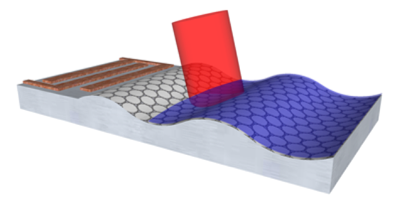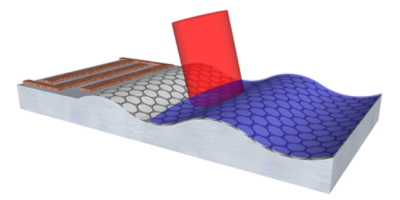Flexing Some Graphene Muscle
Among its many talents, the two-dimensional carbon structure of graphene can sustain surface plasmons—collective electronic oscillations—from midinfrared to terahertz frequencies. Plasmons in this frequency range could be the basis of nanometer-size devices that join electronic functions with optics. However, getting light in and out of graphene plasmons is a tall order: it requires patterning the material with periodic structures to couple photons to the electronic oscillation. Not only does physical patterning prevent tunability, but it also causes energy loss due to scattering off the imposed structure. In Physical Review Letters, two independent research groups propose that inducing vibrations in graphene to create the necessary periodic grating could be a more efficient way to convert photons to plasmons.
In one report, Mohamed Farhat at the King Abdullah University of Science and Technology (KAUST), Saudi Arabia, and his colleagues consider a sheet of graphene nudged at one side by a mechanical actuator. This generates flexural waves on the graphene sheet, which establish the grating pattern required to have energy flow from incident light into surface plasmons. By matching the wave number of the incident field with that of the plasmon, the coupling can be markedly enhanced. By their calculations, one could couple of the light energy, as opposed to for unmodulated graphene.
In the other report, Jürgen Schiefele, at the Complutense University of Madrid, Spain, and colleagues propose placing the graphene sheet on a piezoelectric substrate. Electrically induced mechanical vibrations set up the graphene modulation that matches the photon and plasmon phases. If developed practically, such devices could be useful in highly sensitive chemical detection, conversion of light to electricity, and nano-optoelectronics. – David Voss





